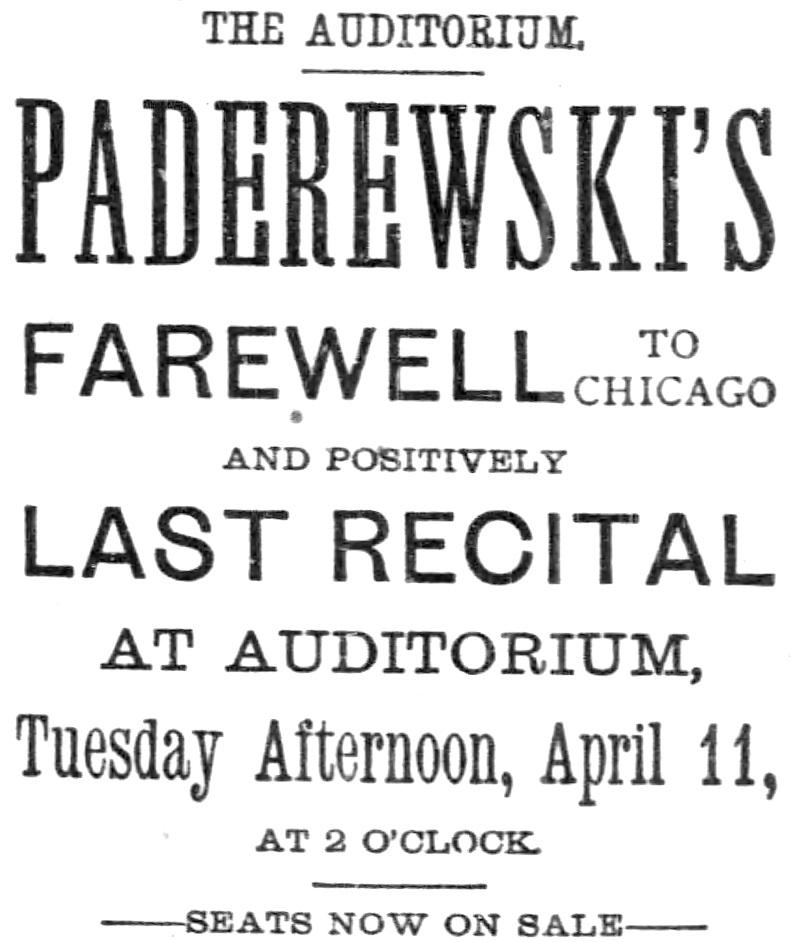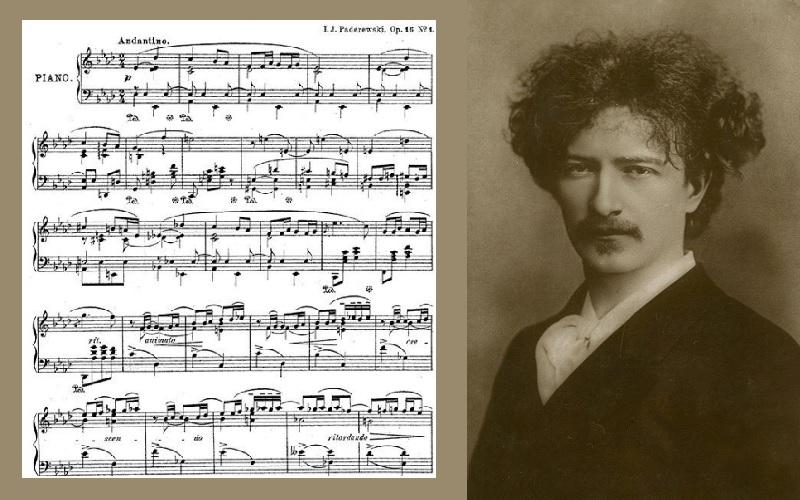Who possessed enough star power to follow President Grover Cleveland after he triumphantly opened the World’s Columbian Exposition in Chicago on May 1, 1893? That honor went to the most famous musician of the time—twenty-two-year-old Polish pianist Ignacy Jan Paderewski, who commanded the stage in Music Hall the next night. His finesse with the ivory keys, his unwieldy mass of luxuriant red hair, and his stage magnetism earned him great celebrity, a devoted and swooning audience, and more than a few media caricatures and lampoons. The infatuation he induced among women in his audiences earned the diagnosis of “Paddymania.”
Later in life, Paderewski became a philanthropist, planted early Zinfandel vineyards on the California Central Coast, and served as the Prime Minister of newly independent nation of Poland in 1919. His autobiography, The Paderewski Memoirs, published just before his death in 1941, include fond memories of his time at the 1893 World’s Fair. He recalls spending “about a fortnight” in Chicago, including in unfinished rooms on the fairgrounds, “before the official opening of the Fair” on May 1, 1893. When this might have been is unclear, as Paderewski was touring America continuously in the spring of 1893 with no identifiable fortnight spent in Chicago.
He performed with the Chicago Symphony Orchestra on March 3 and 4, 1893; postponed from February 24 due to an injured finger. His tour brought him twice more through Chicago, where he offered piano recitals at the Auditorium on March 8 and April 11. The latter reportedly was to be his “positively last” concert in Chicago. A few days after this farewell performance, newspapers announced that Theodore Thomas of the Columbian Exposition’s Music Bureau had contracted Paderewski for concerts during the opening week of the Fair. His final three weeks in Chicago proved tumultuous, with the artist at the center of a public battle over piano brand promotion.

An advertisment for Paderewski’s “Farewell to Chicago” concert on April 11, 1893. He performed at the opening the World’s Columbian Exposition just three weeks later. [Image from the Chicago Tribune Apr. 8, 1893.]
A serious (though short-lived) proposal that Ignacy Paderewski play on all the various piano brands during his concert at the 1893 World’s Fair did not earn his approval—but did provide a fun visual gag for the cover of the May 15, 1893, issue of World’s Fair Puck magazine.
From The Paderewski Memoirs (Collins, 1939):
And now we shall pick up again the dropped thread of my second American tour which brings us to an important event in the American scene—the World’s Fair which took place in Chicago. That was a tremendous happening and drew people not only from all parts of the country, but from all over the world.
I received an invitation from the Committee of the World’s Fair to appear there with Theodore Thomas’s Orchestra in the concert hall especially built for musical productions at the Exposition. This was to take place in May 1893, towards the end of my tour.
I was very much interested in the World’s Fair because it was an opportunity to see those energetic and ambitious leaders of Chicago at their best. Chicago already had impressed me more than any other city in America. As I have already mentioned, when I first arrived in New York, forty-five years ago, one of the largest buildings at that time was the Windsor Hotel. Chicago already had several skyscrapers, as they are so admirably and aptly called. They had the first skyscrapers, although many people, particularly foreigners, do not know this and think that New York built the first ones. But to Chicago must go the credit for that amazing development. It was the “Windy City” (by no means a misnomer) that was the very first to introduce these huge buildings in America. There was already a perfectly tremendous building, I think the Masonic Temple, which was nineteen or twenty stories high. The appearance of that building was extremely impressive after all the large, but low, buildings in New York. There was also a huge hotel called The Auditorium, which contained the concert hall in which I made my first appearance, the largest hall at that time in the entire country.
Everywhere there was to be noted a strong movement towards the beautifying of the city. Several parks had already been started. There has always been a strong civic feeling in Chicago, and the Exposition gave a still greater emphasis to that collective activity.
At that time there were in my mind three things of colossal dimensions in America which impressed me as being objects of condensed immensity. I find no other way to express it. Niagara Falls, the City of Chicago, and the Grand Canyon. Niagara Falls has that condensed immensity—although it is comparatively small, yet it impresses one as a world in itself, and terrific—of indescribable power and beauty. The Grand Canyon, which I saw a few years later, gave me again that impression of a colossal strength concentrated in one considerable area; and Chicago, with that stupendous driving force which was pushing those eager millions of population towards their goal, gave me again the impression of that concentrated immensity similar to those two cataclysms of nature. But while Niagara Falls and the Grand Canyon were the results of brutal forces of nature, Chicago appealed to me then as being the result of all the tremendous, but intelligent, forces of mankind.
There was a large group of men, leaders in that activity, whom I had the opportunity of meeting upon my arrival. The grounds of the World’s Fair were like a huge camp. It was a strange sight. All the men who were directing those colossal preparations were practically living (really camping) there on the spot. We spent there, before the official opening of the Fair and the concerts, about a fortnight, living in rooms which were not yet even finished. We lived and slept there. It was most uncomfortable but exciting. Everything was in great disorder. The plaster covering the walls was not yet dry. Everything had been put up in a hurry. There was humidity everywhere, coming not only from the neighbouring lake, but from the dampness of the buildings.
The committee invited me to stay there and it was certainly a unique experience. Had I realised what was in store for me I probably should never have accepted the invitation. It was something fantastic in its discomfort. But the strangeness and adventure of it all appealed to me. Like everything in America on my arrival, it filled me with a great wonder and excitement. America was a land of miracles—performed “overnight” as you say. Among the outstanding figures in this enterprise, there was a man of actual genius by the name of Daniel Burnham, who was practically the creator of all that was beautiful in Chicago then. He was probably the greatest architect of that time, a beautiful man, full of imagination, of high culture, and above all a man always thinking about the good of his fellow citizens, and devoting to it all his energy and strength. Burnham was really the constructive genius of the World’s Fair. It was his driving force that carried the enterprise through triumphantly.
So many of Chicago’s important men were active and creative in the great World’s Fair. It was a tremendous outpouring of civic pride and feeling on the part of every one concerned. I knew only a few of them at that time, but I remember particularly the Deering brothers, Cyrus McCormick and Charles Atwood, the architect. Theodore Thomas was conducting all the orchestral and choral performances during the Exposition.
Grover Cleveland, then President of the United States, formally opened the Chicago Fair, in the presence of at least half a million people. It was something really gorgeous. He made on that occasion a beautiful, impressive address. I met him only once, and I never saw him again, but one knows of him as one of America’s greatest Presidents.
The concerts were most successful, but the pleasure I had was not without certain unpleasant surprises. I was then playing everywhere the Steinway piano, and the House of Steinway, for some reason best known to themselves, did not wish to exhibit at the Fair. The competitors of that illustrious firm started an opposition and wanted me to be prevented from playing, at the Exposition, an instrument which was not exhibited. It took all the energy and skill and tact of Theodore Thomas and all his friends to obtain the agreement of the committee to my playing on a Steinway piano.
It was a very bad situation, but finally I was allowed to play the Steinway, without, however, having been able to stop the bitter controversy which was going on at that time and which still went on for months in the newspapers, because every one of those competitors had their supporters, and they were fighting on legal grounds.
I do not know now and did not know then why the Steinways did not exhibit there, but they must have had some very important reasons, I’m sure.

